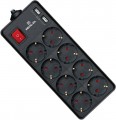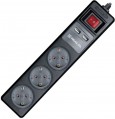Cable length
The length of the cable used to connect the surge protector to the network.
The longer the cable, the farther from the outlet you can install the device. On the other hand, a long cable can be inconvenient over short distances. Models on a coil are deprived of this drawback (see "Type"), this moment is compensated by the actual presence of the coil, but they differ in large dimensions and heavy weight. So when choosing, it is far from always worth chasing the maximum length of the wire.
Max. energy absorption
The maximum energy absorption provided by the mains filter, namely, the maximum pulse energy at which the device can safely absorb and dissipate it, completely protecting the connected load. The higher this indicator, the more reliable the filter, the more powerful power surges it can handle. In inexpensive models, the maximum absorption is calculated in tens of joules, in the most advanced models it can exceed 1000 J and even 2000 J.
Grounded sockets (type F)
The number of
sockets with type F grounding, provided in the design of the mains filter.
In this case, we are talking about full-size European type F sockets with metal ground clamps on both sides at the edges of the socket. The "socket" in this case means a CEE 7/4 ("Schuko") standard plug. Grounding is required for the safe operation of some types of electrical appliances, in particular, washing machines and other machines that work with water, refrigerators, computers, audio equipment, etc. A detailed list can be found in the reference literature. If you plan to connect such devices through the filter, this filter must have sockets with grounding.
Protection
—
Short circuit protection. Short circuit (short circuit) protection system — situations when the impedance in the circuit drops sharply, for example, due to a metal object falling between the socket contacts. It reacts to a sharp increase in current and opens the circuit, allowing you to avoid damage and fire equipment.
—
Voltage drops protection. Protection against power surges in the network. A filter with this function is able to completely cut off power that exceeds the allowable rate set by the manufacturer, protecting the load from damage. Note that the surge protector is not able to replace a full-fledged stabilizer or voltage relay; however, in more or less high-quality networks that are not subject to strong fluctuations, a filter is quite enough.
—
Overload protection. In this case, overload means a situation when the load power exceeds the values \u200b\u200ballowed for a given network filter. This situation is similar to the short circuit described above — high currents go through the filter; however, overload has its own specifics, so protection against it can be provided as a separate system. However, the principle of operation of such systems is classic: when the permissible power is exceeded, it turns off the power, preventing breakdowns and fires.
—
Varistor protection. A kind of protectio
...n against short-term power surges in the network, built on varistors — variable impedance resistors. The impedance of such a resistor under normal conditions is in the millions of ohms, but it drops sharply if the input voltage increases above a certain value. Due to this, in normal mode, the protection practically does not affect the circuit, and with a high-voltage pulse, excess energy “merges” through the varistor and dissipates in the form of heat. The ability of varistors to absorb energy is not infinite, therefore, to protect against overheating, the design usually provides for a temperature sensor with an automatic switch.Wall mount
Availability
of fastening on a wall in a network filter design. Such fastening most often has the form of a characteristic eyelet (loops), designed to be put on a nail driven into the wall or other similar detail. And the installation on the wall itself is convenient in that the filter can be quite close to the user, and besides, it does not take up space on the floor (which, among other things, minimizes the risk of stepping on the device, damaging it during cleaning, etc.) .
Outlets location
Options for placing sockets on the body of an extension cord or surge protector.
-
Along the hull. Devices with the layout of sockets in one slender line, which is extended along the entire body of the extension cord or surge protector.
-
In 2 rows. A popular scheme with the arrangement of sockets in 2 rows is on both sides of the upper plane of the device housing.
-
In a circle. This category includes all extension cords and surge protectors with sockets in the form of a full circle or a semicircle.
-
On both sides of the body. Sockets on several side faces of the case are found in compact cube models and in advanced surge protectors with relocated sockets on both sides of the case, which makes it easy to connect a large number of consumer devices.

